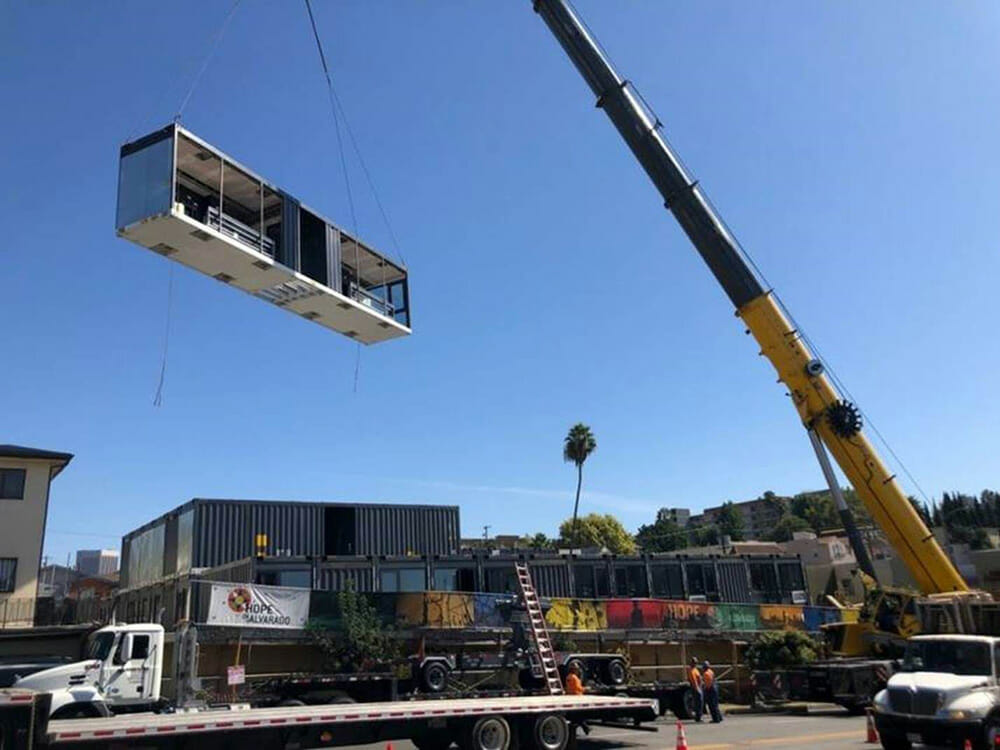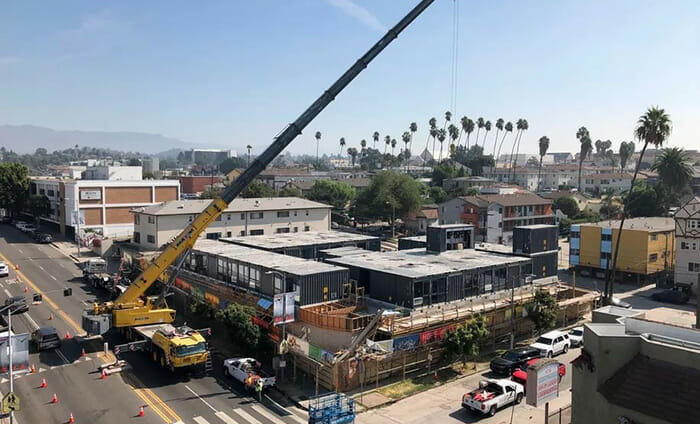Modular Design: The Software, The Process, The Future

Anthony Gude is the Director of Operations at R & S Tavares Associates, a company based in San Diego, California. Founded in 2002 by Ralph and Silvana Tavares, the firm provides services that include design, structural engineering, consulting, and project management for construction clients across the United States. Most of the company’s work involves designing and engineering pre-fabricated buildings.
Early design
Anthony Gude emphasizes the familiar advice to bring all the key players on a project together early in the design process. “Everyone says this — because it’s true!” Gude says. “Nobody has all the necessary information at the start, especially on innovative or large-scale projects. A conference call with 20 or 30 people giving input at the pre-design stage is not uncommon.
”There will be numerous design iterations while the team explores project feasibility and it’s important to remain flexible during this process. “Re-designs — such as designing a whole building in steel and then re-designing in wood, or vice versa — often happen because someone was pulling in a particular direction too soon,” Gude says. “So have that group discussion first, and get all the information and constraints on the table from the beginning.”
If the design team is brought in too late, or if the wrong fabricator is chosen for a project, “then you’re setting yourself up for failure.”

Processes vs execution
Speaking of failures, Gude says that when modular construction has been criticized for poor outcomes, it’s often been without considering the causes of those outcomes. “We need to distinguish between the processes of modular design and construction on the one hand, and the execution of those processes on the other. Problems executing the processes can result in poor outcomes — that doesn’t mean there’s something wrong with the processes themselves,” Gude says. “It’s like someone failing to reach their destination on a bicycle because they fell off. That poor outcome doesn’t mean there’s something inherently wrong with the process of bicycle-riding. It means that, on that occasion, there was a problem with executing that process.”
It’s particularly important to make sure everyone on the team for a project is well-suited to it. For example, an owner might require a large cantilevered deck on the top floor of a building. A specific fabricator may be better suited to design and custom-manufacture that building because they’re experienced with the details of the required connections. However, if the owner has contracted with a fabricator who doesn’t have that experience, “then the project may not be able to overcome the design constraint due to the mis-match in capabilities. The shortcoming in this case is not in the modular design and manufacturing processes themselves — but rather it’s due to the specific decisions of those leading the project.”
Similarly, start-up ventures may lack the right kind of knowledge and experience. They might have a type of end product in mind, but have a mismatch with the type of fabrication or material they want to use. “For example, shipping containers are not suitable for every type of end product,” Gude says. “There comes a point where you have to do so much re-work or structural re-design of containers that the project team should have used one of the other solutions available to the volumetric modular industry.”


Photo credit: KTGY Architects
Related Listening:
How Owner/Developers Can Best Get Started with Modular Construction w/ R & S Tavares Associates
In this episode, Pedro Tavares and Anthony Gude of R & S Tavares Associates share best practices for owner/developers looking to incorporate modular construction into their upcoming projects.
Re-using design elements
A major advantage of modular construction is the ability to re-use design elements on multiple projects, thus reducing costs. R & S Tavares recently put this into practice on the HOPE projects, which are supportive housing developments in the greater Los Angeles area.
These developments have been sponsored and supported by local governments that are committed to a longer pipeline — not just one or two projects. This means the entire design and construction team can also commit to multiple projects and deliver on modular’s promise of more economical housing. “Because the team was invested in multiple projects, we developed core designs that could be reconfigured in a variety of ways to best suit each individual project,” says Gude.
Design software
Gude mentions some software products, such as Archistar, Hypar, and Kreo, which “help with everything from site feasibility, all the way through to parametric design and modeling.” These kinds of software create renderings based on “the general parameters of the building — how the modules connect, the type of building, the number of stories, wind loads, snow loads, etc.”
R & S Tavares is working on a portal where clients can pick from a library of pre-designed elements and, combined with the input of high-level design constraints, the software will render a rough draft model to use as a basis for early discussions. The rough draft functions like an initial feasibility study for the client.
“With this technology, we can effectively download our early project feasibility decision tree, and have an algorithm make those assumptions for us,” says Gude. “And then we can do the detailed design based on the resulting draft model — instead of investing time and effort into a detailed design that it turns out later the client isn’t on board with.”
Sharable digitized designs
Gude says sharable digitized designs will help move modular construction towards truly industrialized design and manufacturing, making the industry more efficient and reducing costs. He says modular fabrication is not yet homogenous enough to share designs widely and he predicts that, first, “engineering firms that specialize in fabrication and manufacturing will learn to own and distribute their design details as digital products.”
One problem with sharing digitized designs is that the original designer can lose control of the design. “Illegal use of design details is rampant the architecture, engineering, and construction industries,” Gude says.
The solution lies with technology-enabled ledgers, Gude explains. This allows code to serve like a unique barcode that attachs to a digital product, which acts like a certificate of authenticity. These certificates can guarantee that the original designer will reap some benefit every time someone acquires a copy of the design — like royalties going to an author every time a copy of their e-book is sold.
“All the technology for this already exists,” Gude says. “As it becomes more widely adopted, it’ll be a game-changer for permitting and design workflows. It will allow us all to maximize the benefit of modularization and industrial design in construction.”
This article was first published in the Modular Advantage - May/June 2021 Edition.
About the Author: Zena Ryder is a freelance writer, specializing in writing about construction and for construction companies. You can find her at Zena, Freelance Writer or on LinkedIn.
More from Modular Advantage
Resia: Breaking All the Rules
Resia Manufacturing, a division of U.S.-based Resia, is now offering prefabricated bathroom and kitchen components to industry partners. Its hybrid fabrication facility produces more precise bathroom and kitchen components (modules) faster and at lower cost than traditional construction. Here’s how Resia Manufacturing does it.
How LINQ Modular Innovates to Bring Modular To The Market in the UAE and Beyond
LINQ Modular, with an office and three manufacturing facilities in Dubai, is a modular firm based in United Arab Emirates. The company is on a mission: to break open the housing and construction markets in the Gulf Cooperation Council (GCC) area with modular.
ModMax: Redefining Modular Construction with Confidence and Precision
ModMax was born out of frustration—frustration with five persistent pain points in modular construction: Permitting bottlenecks. Production delays. Rigid designs. Disconnect between “the office” and the field. Lack of transparency and communication.
LifeArk: Disaster-Resilient Housing from Recycled Plastic and 100-year-old Technology
Wee compares LifeArk’s housing units to Yeti coolers, as they are built similarly. Each component takes 15 to 20 minutes to manufacture, has an R-value of 40, and includes molded slots and chases for wiring, plumbing, fire sprinklers, and other utilities.
Building the Future of Modular Edge Infrastructure
The edge data center market is expanding rapidly, driven by the surge in AI workloads, IoT adoption, and the need for localized compute power. In these environments, sustainability, scalability, and reliability are non-negotiable. Cooling is among the most complex challenges for operators—and one of the most decisive factors in long-term success.
Accelerating Light-Gauge Steel Construction: A Semi-Automated Digital Workflow for Off-Site Projects
For construction professionals, the message is clear. By adopting semi-automation and digitalization, companies can deliver projects faster, more accurately, and more profitably, while also building stronger collaboration across teams. The approach is not about replacing people with machines, but about empowering people with better tools and processes.
Why Modular Data Centers Are Gaining Momentum
Artificial intelligence, high-performance computing, and edge applications push the limits of traditional “stick-built” data centers. They take years build, often struggle with high density workloads, and aren’t optimized for deployments near end users. Modular data center platforms are purpose-built to address these challenges, offering flexibility and scalability to adapt to evolving technologies, while opening new opportunities for the modular construction industry.
Supply Chain Innovation in Action: 5 Habits Every Modular Leader Should Practice
By applying these principles to supply chain practices — collaborative planning, strategic procurement, scenario modeling, digital tools, and transparent forecasting — construction leaders can build value chains that are not just efficient and agile, but truly innovative.
Exploring the Role of Modular Integrated Construction (MiC) in Advancing Circular City Principles – A Survey of Stakeholder Perspectives
The survey findings highlight the significant potential of Modular integrated Construction (MiC) in advancing the development of circular cities. By reducing costs, accelerating construction timelines, and minimizing waste generation, MiC offers a promising approach to sustainable urban development.
The Use of MS POLYMER™-Based Sealants and Adhesives in Modular Building
These products combine flexibility and elastic recovery with excellent adhesion to different substrates and have already shown their usefulness in traditional construction. Now it’s time for them to be put to use in the modular construction industry.










